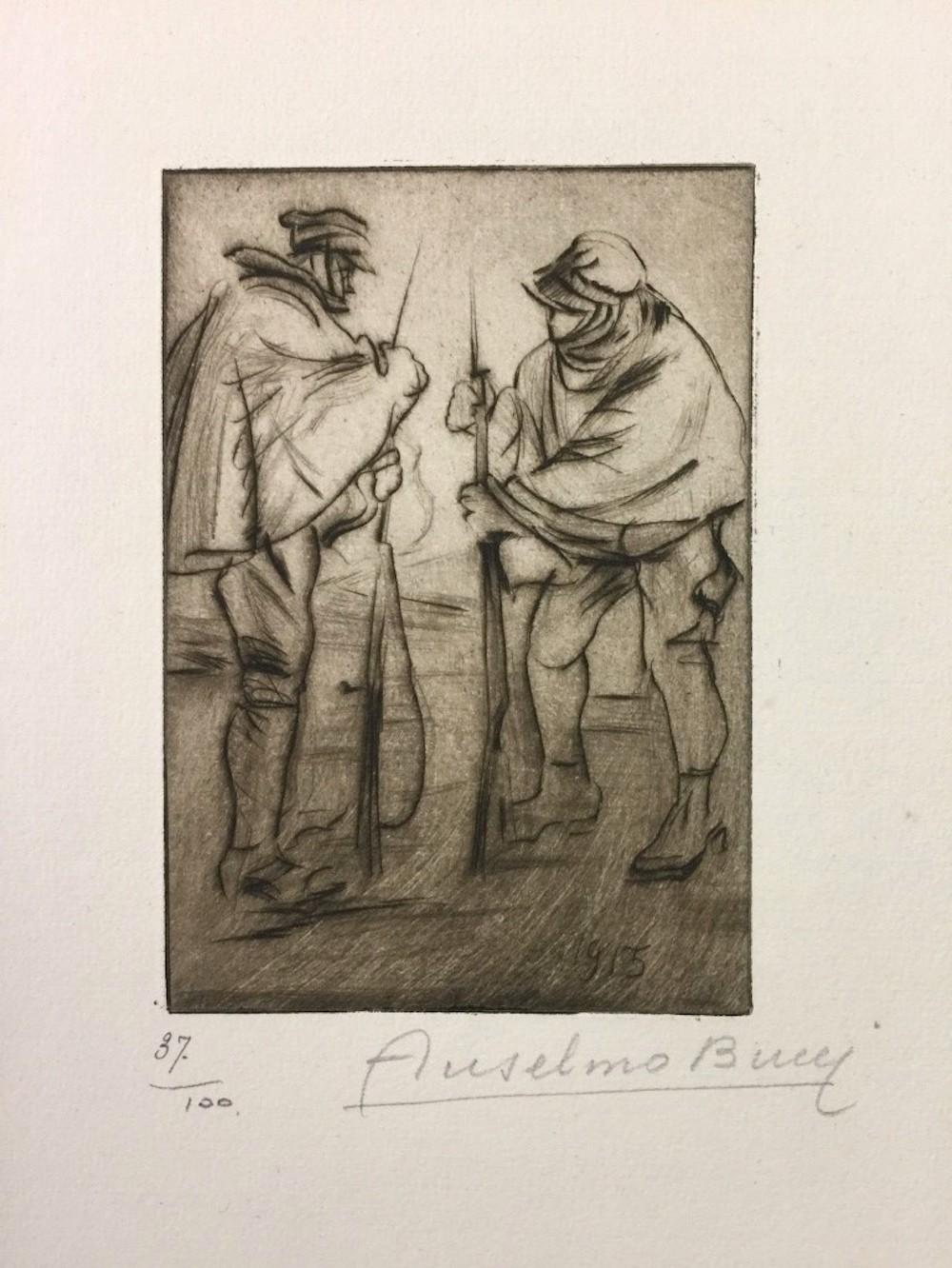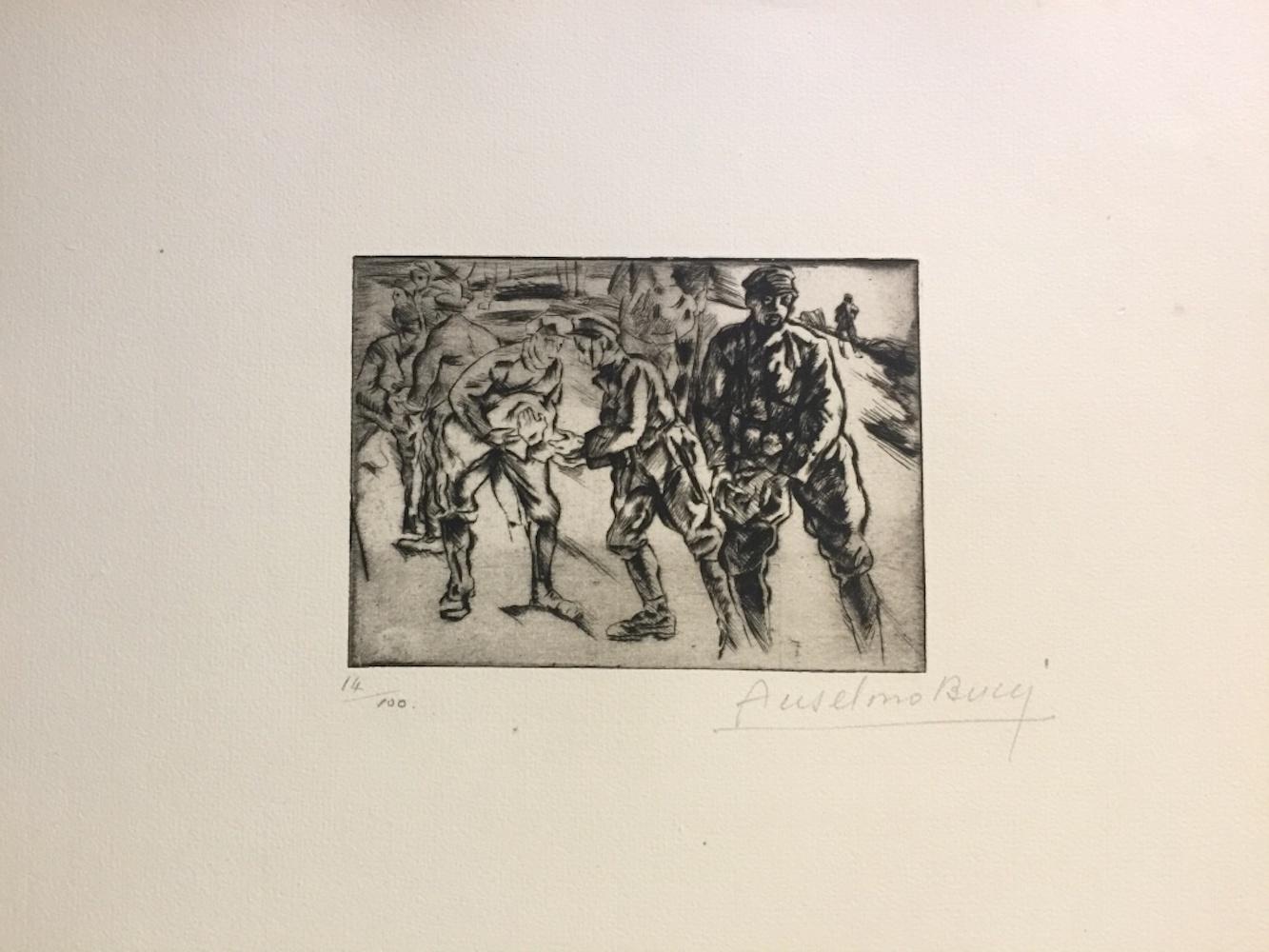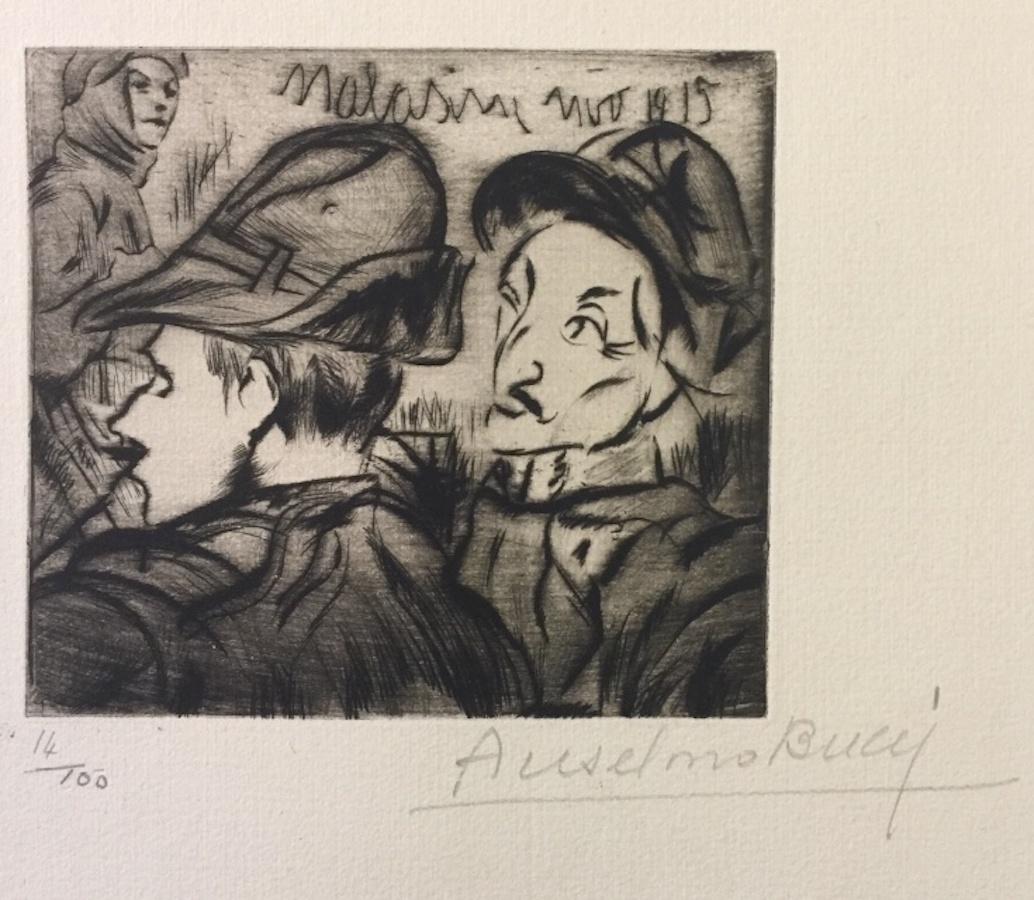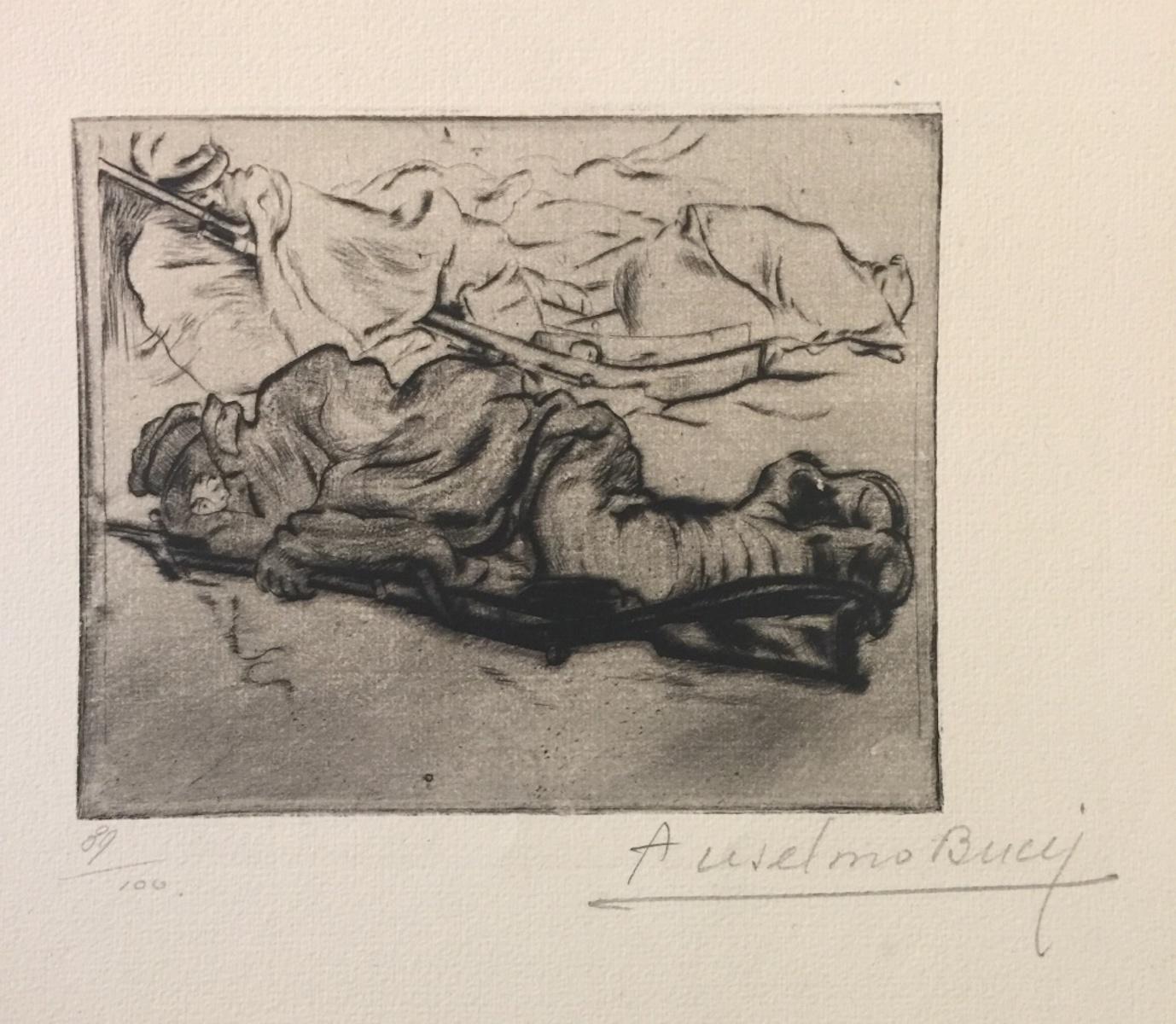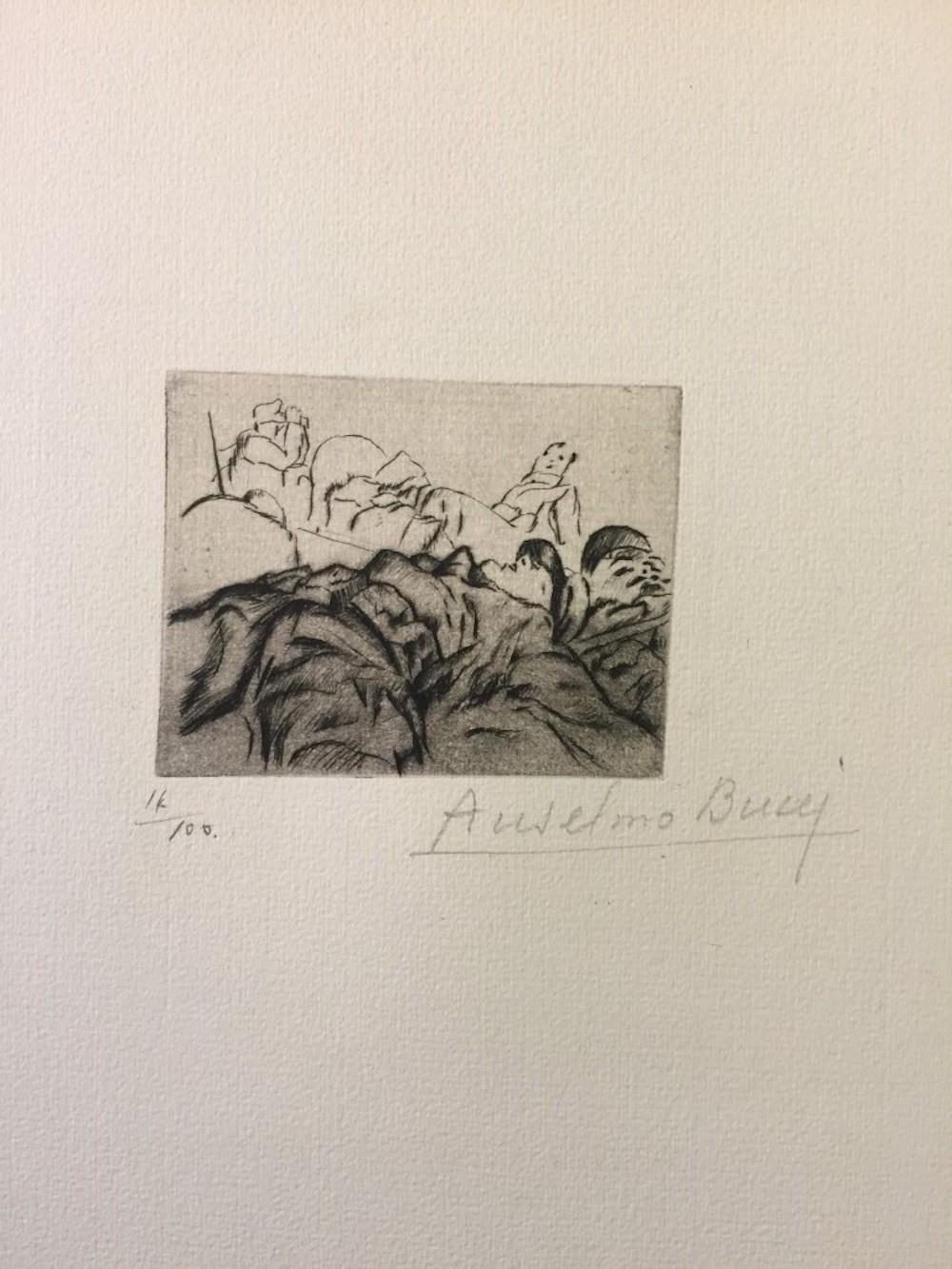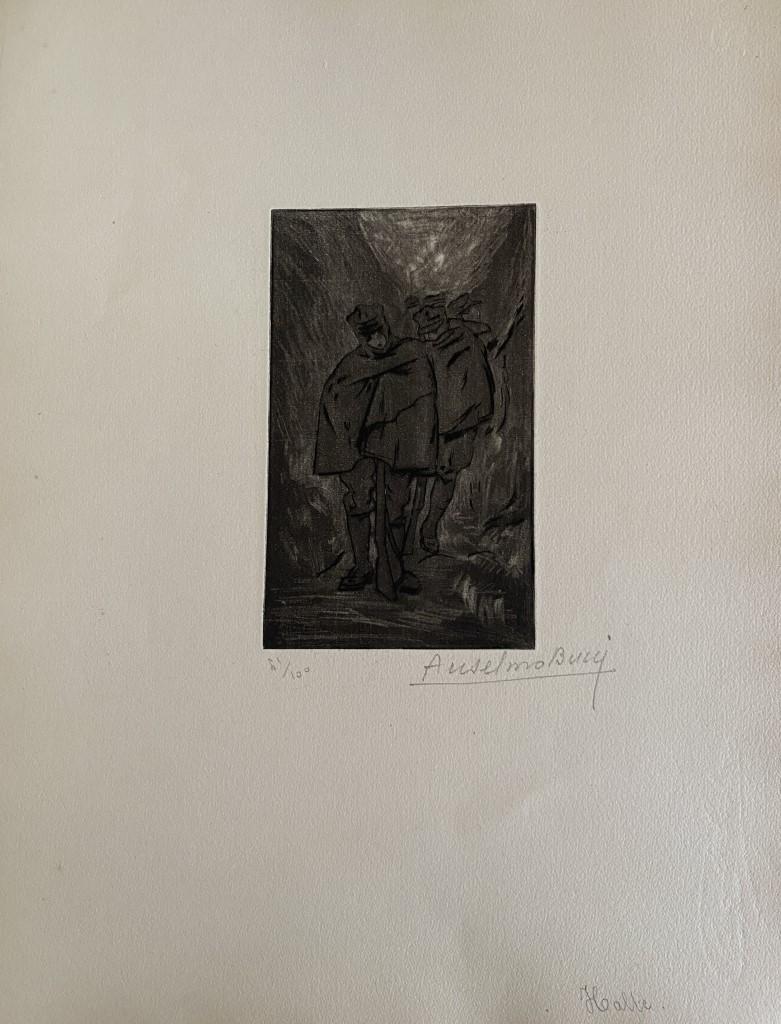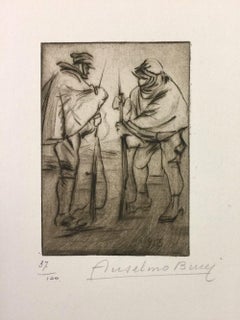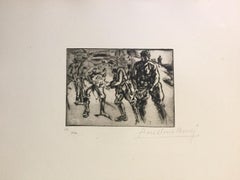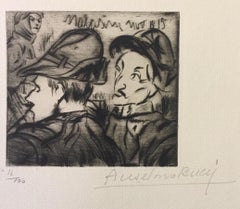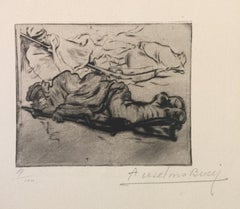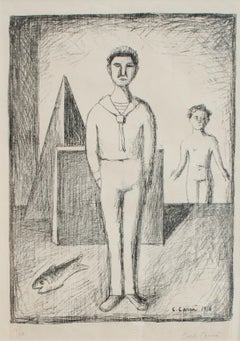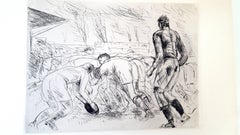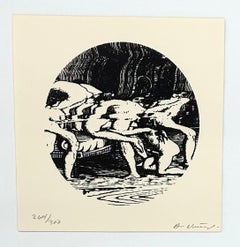Items Similar to Halte - Etching by Anselmo Bucci - 1917
Want more images or videos?
Request additional images or videos from the seller
1 of 6
Anselmo BucciHalte - Etching by Anselmo Bucci - 19171917
1917
$294.24
£224.77
€250
CA$414.60
A$456.51
CHF 236.72
MX$5,406.35
NOK 3,005.02
SEK 2,808.54
DKK 1,904.55
About the Item
Image dimensions: 15 x 9 cm.
Hand signed. Edition of 100 prints on Hollande paper. From the collection: “Croquis du Front Italien” , published in Paris by D'Alignan editions. Anselmo Bucci was an Italian painter and printmaker.
He took part in the Salon des Indépendants from 1910 on. He enlisted in the Volunteer Cyclist Battalion in 1915 and he became one of the most famous Italian war artists. He lives the war experience with a lot of the Futurism movement's exponents. In "Pane e Luna", his biography, he wrote: «Siamo fucilieri dell’ottavo plotone, a guardia notturna del Forte Trimellone e del lacustre Fronte. Tra noi buoni compagnoni sono i chiari Futuristi; altri oscuri per un oscuro compito».
In the series "Croquis du Front Italien" that includes 50 drypoints, Bucci describes scenes of the Italian front in the First World War. During the war, in his battalion there were Marinetti, Boccioni and Sant'Elia.
This artwork is shipped from Italy. Under existing legislation, any artwork in Italy created over 70 years ago by an artist who has died requires a licence for export regardless of the work’s market price. The shipping may require additional handling days to require the licence according to the final destination of the artwork.
- Creator:Anselmo Bucci (1887 - 1955, Italian)
- Creation Year:1917
- Dimensions:Height: 14.18 in (36 cm)Width: 10.83 in (27.5 cm)Depth: 0.08 in (2 mm)
- Medium:
- Movement & Style:
- Period:
- Condition:Insurance may be requested by customers as additional service, contact us for more information.
- Gallery Location:Roma, IT
- Reference Number:Seller: M-940081stDibs: LU65036285962
About the Seller
4.9
Platinum Seller
Premium sellers with a 4.7+ rating and 24-hour response times
1stDibs seller since 2017
7,816 sales on 1stDibs
Typical response time: 1 hour
- ShippingRetrieving quote...Shipping from: Roma, Italy
- Return Policy
More From This Seller
View AllLe Releve - Original Etching by Anselmo Bucci - 1915
By Anselmo Bucci
Located in Roma, IT
Image dimensions: 12.5 x 8.5 cm.
Hand signed. Edition of 100 prints on Hollande paper. From the collection: “Croquis du Front Italien”, published in Paris by D'Alignan editions. Ans...
Category
1910s Futurist Figurative Prints
Materials
Drypoint, Etching
La Chaîne - Etching by Anselmo Bucci - 1917
By Anselmo Bucci
Located in Roma, IT
Image dimensions: 9.5 x 13.5 cm.
Hand signed. Edition of 100 prints on Hollande paper. From the collection: “Croquis du Front Italien” , published in Paris by D'Alignan editions. An...
Category
1910s Futurist Figurative Prints
Materials
Drypoint, Etching
Alpino - Etching by Anselmo Bucci - 1917
By Anselmo Bucci
Located in Roma, IT
Image dimensions: 10 x 9.5 cm.
Hand signed. Edition of 100 prints on Hollande paper. From the collection: “Croquis du Front Italien” , published in Paris by D'Alignan editions. Anse...
Category
1910s Futurist Figurative Prints
Materials
Drypoint, Etching
$264 Sale Price
25% Off
Le Froid - Original Etching by Anselmo Bucci - 1917
By Anselmo Bucci
Located in Roma, IT
Image dimensions: 11.5 x 14 cm.
Hand signed. Edition of 100 prints on Hollande paper. From the collection: “Croquis du Front Italien”, published in Paris by D'Alignan editions. Ans...
Category
1910s Futurist Figurative Prints
Materials
Drypoint, Etching
Extenués - Etching by Anselmo Bucci - 1917
By Anselmo Bucci
Located in Roma, IT
Image dimensions: 6 x 8 cm.
Hand signed. Edition of 100 prints on Hollande paper. From the collection: “Croquis du Front Italien” , published in Paris by D'Alignan editions. Anselmo...
Category
1910s Futurist Figurative Prints
Materials
Drypoint, Etching
Militant - Original Etching by Anselmo Bucci - 1917
By Anselmo Bucci
Located in Roma, IT
"Military" 1917 is a beautiful print in etching technique, realized by Anselmo Bucci (1887-1955).
Hand signed. Numbered 61/100 of prints on the lower left. On the lower right corner...
Category
1910s Modern Figurative Prints
Materials
Etching
You May Also Like
Carlo Carrà 1916 Futurist Lithograph
By Carlo Carrà
Located in New York, NY
Carlo Carrà (Italian, 1881-1966)
Untitled, 1916
Lithograph
Sight: 15 3/4 x 11 1/4 in.
Framed: 23 1/2 x 18 1/2 x 1 in.
Edition 14/60
Numbered lower left, signed and dated lower right
...
Category
1910s Futurist Figurative Prints
Materials
Paper, Ink
André Dunoyer de Segonzac - La Mêlée - Original Etching
By André Dunoyer de Segonzac
Located in Collonge Bellerive, Geneve, CH
Charles Martin - La Mêlée - Original Etching
Dimensions : 13 x 10".
Paper : Rives vellum.
Edition : 225 copies.
1927
From Tableaux de Paris, Emile-Paul Freres, Paris
Category
1920s Modern Portrait Prints
Materials
Etching
Antonio Nuñez Cuban Artist Original Hand Signed engraving 2002
Located in Miami, FL
Antonio Núñez (Cuba, 1971)
'Untitled (La Huella Múltiple)', 2002
engraving on paper
8.1 x 8.1 in. (20.5 x 20.5 cm.)
Edition of 300
ID: HUE-241
Hand-signed by author
Category
Early 2000s Contemporary Prints and Multiples
Materials
Paper, Screen
Jean Jansem - Original Etching
By Jean Jansem
Located in Collonge Bellerive, Geneve, CH
Jean Jansem - Original Etching
Title: Loneliness
Dimensions: 40 x 30 cm
Edition of 175
Paper: vélin de Rives
1974
Unsigned and unumbered as issued
Category
1970s Modern Figurative Prints
Materials
Etching
Surrealist Figurative Aquatint Etching California Modernist Sculptor Artist
By Jack Zajac
Located in Surfside, FL
Jack Zajac, American, born 1929
1964 Etching and aquatint hand printed on Fabriano paper, pencil signed and editioned.
Edition Roman Numeral III
Image: 12 9/16 x 8 5/8 in. (31.9 x 2...
Category
1960s Surrealist Figurative Prints
Materials
Etching, Aquatint
Jakob Steinhardt Jewish German Expressionist Lithograph Israeli Early Bezalel
By Jacob Steinhardt
Located in Surfside, FL
plate signed.
Jacob Steinhardt
1887-1968
Steinhardt, Jakob, Painter and Woodcut Artist. b. 1887, Yaacov Steinhardt was born in the then remote, largely Polish town of Zerkow in the Posen District of Germany. (poland/german) Immigrated 1933. Studies: 1906 School of Art, 1906 Studied in Berlin Arts and Crafts School. Berlin; 1907 painting with Lovis Corinth and engraving and etching with Hermann Struck; advanced studies, 1908-10 Paris, with Henri Matisse and Steinlen; 1911 Italy. Teaching: Bezalel, Jerusalem, 1953-57 Director. 1910 Participated in the “New Sezession”, Berlin. 1912 together with Ludwig Meidner and Janthur he founded the "Pathetiker" group very early in the German expressionist movement. Running afoul of the Nazis, he fled to Tel-Aviv and then Jerusalem in the early 30s, showing in “Der Sturm” Gallery. 1914 Exhibited with ludwig Meidner at first Expressionist Exhibition in Berlin. Worked mainly in woodcuts depicting biblical and other Jewish subjects. 1955-58 International awards for his woodcuts. receives graphic commissions from Fritz Gurlitt. 1922 Marries Minni Gumpert. Active in organizing Secession exhibits. 1925 Trips to Mark Brandenburg and Holy Land. Turns primarily to painting; stops work on etchings and lithographs. 1933 Emigrates to the Palestine. 1934 Moves to Jerusalem and opens an art school; attempts some etchings. 1948 Closes the art school and becomes Chairman of Graphics Department, Bezalel School for Arts and Crafts. 1954-57 Director of Bezalel School for Arts and Crafts. Taken up by J. B. Neumann who became the agent for his etchings. Exhibited Sturm Gallery, Herbst-salon. 1914 Outbreak of World War I; Steinhardt enlists in German army. 1916-18 First on Eastern Front in Poland and Lithuania, then after short training period in Berlin, sent to Macedonia. 1917 Exhibition of Lithuanian drawings at Berlin Secession in Spring. Elected member of the Secession.
He often used wood-cutting techniques that were popular amongst German Expressionists. Steinhardt was driven to express ideas clearly and decisively through art.
Amongst the themes found in his work the prophets of the Bible, such as Jonah, are noticeable. Steinhardt identified deeply with Jonah due to his attempt to run from God's call to duty.
Additionally, the image of beggars was often found in Steinhardt's works and in his artistic presentation of the less fortunate, the artist's love for his fellow man becomes evident.
Moreover, the grotesque was a theme noticeable in Steinhardt's earliest pieces. These were fantastical images; it was unclear whether or not they were human or demon. In the 1950's, Steinhardt returned to these images upon learning of the Holocaust of Europe's Jews. At that time he resided in New York and there, in the shadow of the skyscrapers, Steinhardt's reaction to WWII was expressed through his art.
A Collection of Works by Artists of the Land of IsraelThe Bezalel National Museum, Jerusalem 1940 Artists: Shemi, Menahem Rubin...
Category
20th Century Expressionist Figurative Prints
Materials
Woodcut
More Ways To Browse
Peter Max Seasons
Peter Max Smile
Peter Schmidt On Sale
Phoebe Cole
Picasso Arena
Picasso Bouquet Of Peace
Picasso Carnival
Picasso Don Quixote
Picasso Heliogravure
Picasso Imaginaire 1969
Picasso Knight
Picasso Lithograph Maternity
Picasso Sable Mouvant
Picasso Salome
Picasso Signed Bull
Pig And Pepper
Piranesi Appia
Prescott Chaplin
